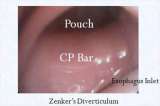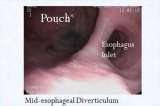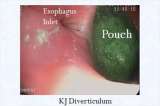Zenker's Diverticulum
Find your care
Our head and neck surgeons consistently rank among the best in the nation. To find out more about our services, call 310-206-6688.
What is Zenker's Diverticulum?
Zenker's Diverticulum is an esophageal pouch that develops in the upper esophagus that causes debilitating dysphagia (difficulty swallowing) and regurgitation of food. It is named after Friedrich Albert von Zenker (1825-1898) who in 1877 published a series of patients with this disorder and described its anatomic pathophysiology.
What is the anatomy of Zenker's Diverticulum?
Zenker's Diverticulum develops in an area of the throat called "Killian's Dehiscence". This area is a potential area of muscle weakness between the inferior constrictor muscle and the cricopharyngeus muscle. The full thickness wall of the esophagus forms a pouch at this location. The diverticulum typically is left sided but as it gets larger it forms in a central posterior location.



How is Zenker's Diverticulum Diagnosed?
The Head and Neck Surgeons at the UCLA Swallowing Disorders Center will diagnose Zenker's diverticulum based on a combination of your dysphagia history as well as swallow evaluation tests such as barium esophagram, videofluoroscopic swallow study, fiberoptic endoscopic evaluation of swallowing (FEES), and transnasal esophagoscopy.
With these techniques the diagnosis can be made with 100% accuracy. It is very important to distinguish a Zenker's diverticulum from a Mid-esophageal diverticulum or a Killian-Jamieson (KJ) diverticulum. Office-based transnasal esophagoscopy is often used to distinguish between these possibilities if diagnosis is unclear based on radiological studies.
Presenting Symptoms and Zenker’s Diverticulum Size
- The distribution of presenting symptoms across size groups is presented in Table 1.
- In our published experience the following presenting symptoms were found.
- Results are presented based on size of the diverticulum (Small < 1 cm, Medium 2-3 cm, Large > 3 cm).
| Table 1 | Small | Medium | Large | All | ||||
|---|---|---|---|---|---|---|---|---|
| Symptom | % | n | % | n | % | n | % | n |
| Solid dysphagia | 83.3 | 5 | 100.0 | 26 | 100.0 | 17 | 98.1 | 51 |
| Liquid dysphagia | 16.7 | 1 | 34.6 | 9 | 23.5 | 4 | 30.8 | 16 |
| Regurgitation | 16.7 | 1 | 68.0 | 17 | 68.0 | 17 | 64.7 | 33 |
| Aspiration | 16.7 | 1 | 19.2 | 5 | 5.9 | 1 | 13.5 | 7 |
| Globus | 33.3 | 2 | 11.5 | 3 | 0.0 | 0 | 9.6 | 5 |
| Chronic cough | 83.3 | 5 | 42.3 | 11 | 41.2 | 7 | 46.2 | 24 |
| Weight loss | 16.7 | 1 | 30.8 | 8 | 29.4 | 5 | 28.8 | 15 |
| Gastrostomy tube or total parenteral nutrition | 0.0 | 0 | 0.0 | 0 | 11.8 | 2 | 3.8 | 2 |
How is Zenker's Diverticulum Treated?
Contemporary treatment of Zenker's diverticulum involves an "endoscopic approach" and division of the common party wall between the esophagus and diverticulum. Endoscopic approach refers to the approach to the diverticulum through the mouth. An "open approach", where an incision is made on the neck to expose and remove the diverticulum is rarely necessary.

The success of the endoscopic approach is highly dependent on the experience of the surgeon.
Endoscopic surgery generally leads to a shorter hospital stay and an earlier time to resuming food by mouth. In addition, laser surgery is able to completely divide more of the common party wall as compared to the endoscopic stapling techniques.
Image: Endoscopic Treatment of Zenker's Diverticulum
The goal is to divide the party wall and perform a diverticulotomy; Zenker's sac persists (NOT resected) but food is now able to drain into the esophagus without collecting in the pouch.
What is UCLA's experience with treatment of Zenker's Diverticulum surgery?
The UCLA Swallowing Disorders Center is at the forefront of diagnosis and surgical treatment of Zenker's Diverticulum. The Center recently published its experience in 46 patients treated during a 6 year period.
Publications & Articles
What Is the Best Technique for Diagnosing Esophageal Diverticulum?
Featuring Dr. Dinesh Chhetri (ENT Today)
Dysphagia Characteristics in Zenker’s Diverticulum
Jennifer L. Bergeron, MD, Jennifer L. Long, MD, PhD, Dinesh K. Chhetri, MD (journals.sagepub.com)